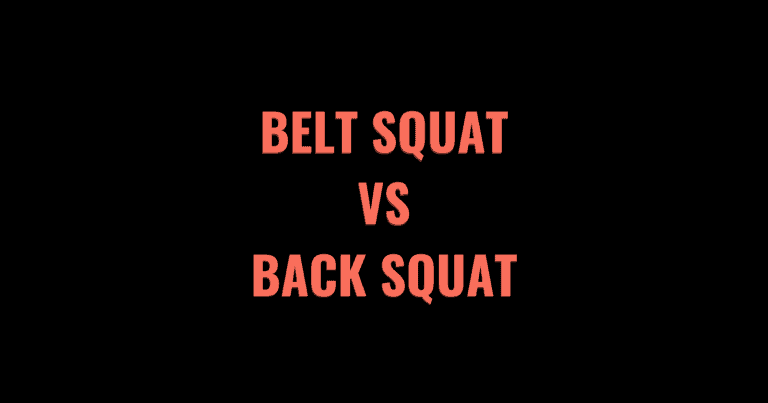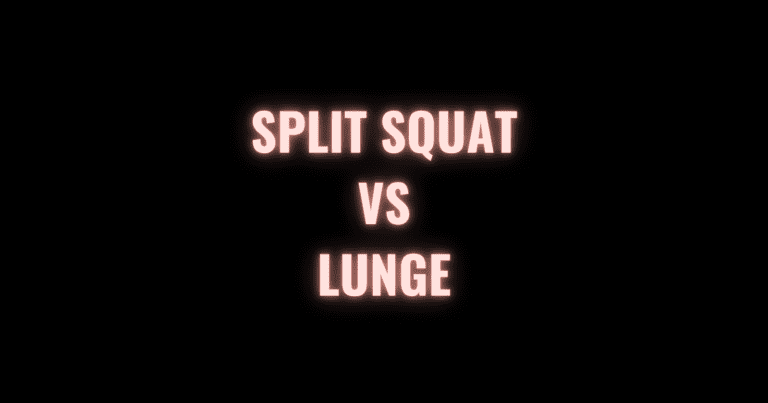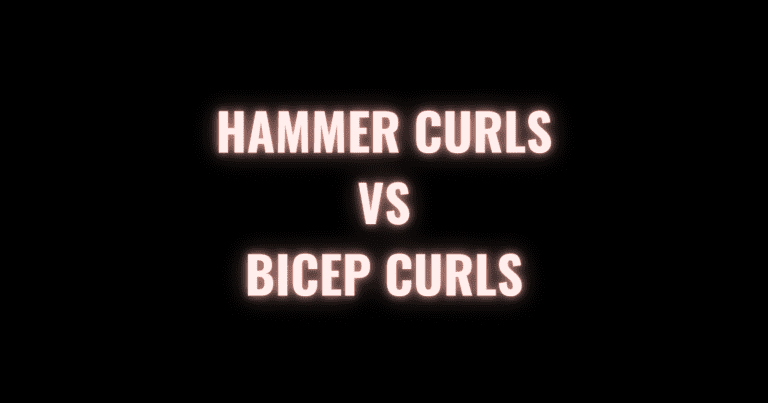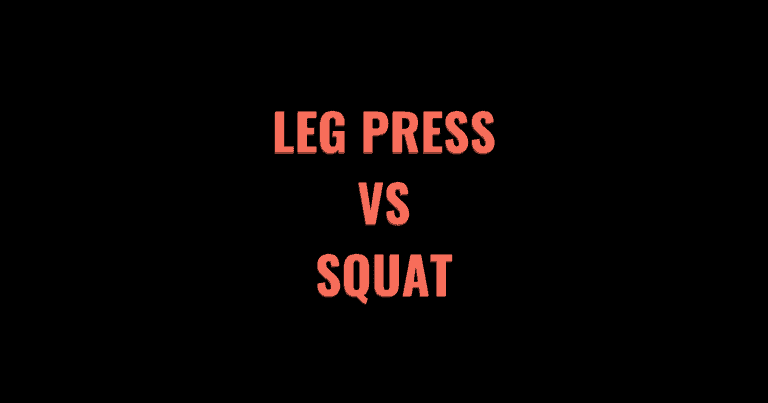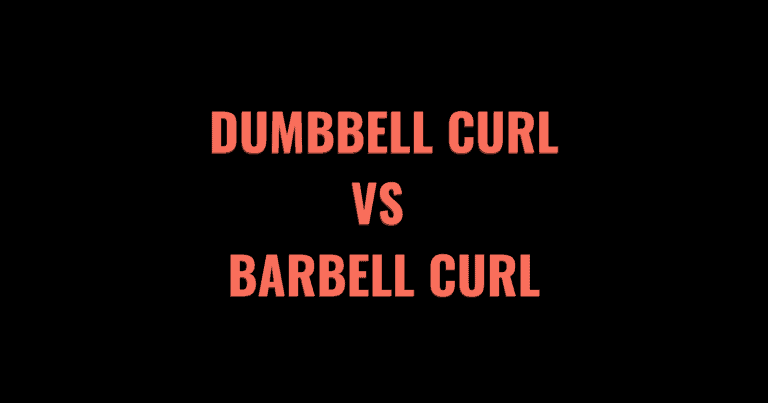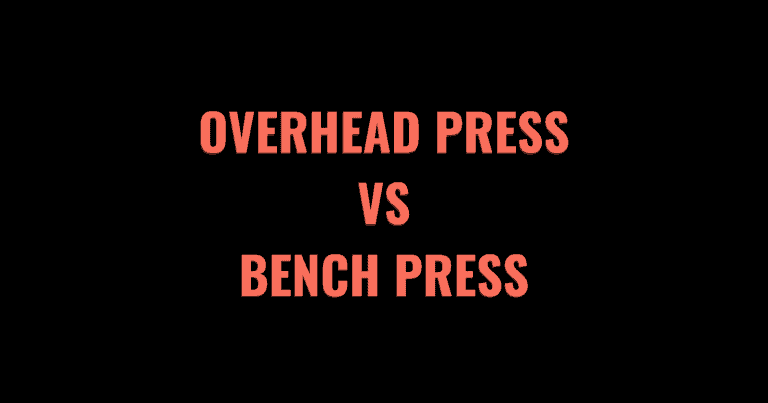The bench press is a well-known lift, popular among bodybuilders, strength, and power athletes alike. However, you may not have heard of a similar movement called the floor press.
Both exercises can form a useful part of your upper body training day. However, there are some important differences.
Here, we’ll go over the main differences between these two upper body pressing movements, the pros and cons of each exercise, and how to include them in your program to build strength and size.
Table of Contents
- 1 Floor Press vs. Bench Press
- 2 Pros and Cons of Each Movement
- 3 When to do an exercise
- 4 Floor Press vs. Bench Press – Muscles Used
- 5 Form Differences
- 6 Helpful Form Cues
- 7 Common Form Mistakes
- 8 Frequently Asked Questions
- 9 Other Exercise Comparison Posts
- 9.1 Flat vs. Incline Bench Press: Which is Better?
- 9.2 Bench Press vs Chest Press: Pros and Cons
- 9.3 Belt Squat vs. Back Squat: Pros & Cons
- 9.4 Split Squat vs Lunge: Differences & Benefits
- 9.5 Hammer Curls vs Bicep Curls: Which is Better?
- 9.6 Leg Press vs. Squat: Differences, Pros, and Cons
- 9.7 Glute Ham Raise vs Nordic Curl: Differences and Benefits
- 9.8 Rack Pulls vs. Deadlifts: Differences, Pros, and Cons
- 9.9 Preacher Curl vs Concentration Curl: Which is Better?
- 9.10 Tricep Extension vs Skull Crusher: Pros and Cons
- 9.11 Barbell Curl vs Dumbbell Curl: Benefits & Differences
- 9.12 Overhead Press vs. Bench Press: Pros, Cons, & Differences
Floor Press vs. Bench Press
What is the main difference between a floor press and a bench press?
The main difference between a floor press and a bench press is the range of motion involved. A bench press allows a greater range of motion. As the bench elevates the torso, the elbows can travel further behind the body to stretch the chest muscles to a greater degree.
A floor press has a limited range of motion as the elbows will hit the ground and reduce the depth that the barbell can achieve, but this can be great for building strict pressing strength in the arms. The greater range of motion in a bench press makes it a better choice for maximizing chest hypertrophy, while the floor press is great for athletes wanting to improve their lockout strength or target the triceps.
Pros and Cons of Each Movement
The floor press and the bench press are very similar exercises, with the main technical difference being whether the lifter is lying on a bench or on the ground. The position changes the range of motion of the exercise and the degree to which the muscles of the chest and arms are activated. The floor press and the chest press have unique pros and cons, which we’ll go over below.
Floor Press Benefits
Here are some of the advantages of floor presses.
- Targets the triceps. The floor press places the triceps under constant tension throughout the lift. The reduced range of motion limits the engagement of the chest muscles that can assist the lift, placing more emphasis on the triceps.
- Builds stronger lockout strength. The floor press can help lifters improve their bench press by strengthening the shoulders and triceps and training the ‘sticking point’ at the lockout phase. Improving your lockout strength carries over to a heavier bench press and more overall strength.
- Protects shoulder health. Some lifters feel shoulder discomfort during a bench press. For many, improper form or arm placement is the culprit. Floor presses provide a feedback mechanism to ensure the scapula is set in place and place less strain on the shoulder due to the shortened range of motion.
- You might be able to lift more weight. The reduced range of motion means you might be able to put more weight on the bar than you can on a bench press. The added load can help with motivation or breaking through training plateaus by isolating the arms with an increased load.
Floor Press Drawbacks
Here are some of the drawbacks of floor presses.
- Some lifters will have to lighten the load. While some lifters will be able to lift more weight due to the reduced range of motion, the opposite can also be true. If the top half of a bench press is your weak point, the floor press is the harder range of a bench press. If you are struggling with your lockout strength, you may need to reduce the weight in a floor press, especially if it is a new exercise for you.
- Less range of motion. Compared to a bench press, the floor press does not permit as much depth in the lift. The reduced range of motion limits engagement of the pecs in a stretched position and inhibits hypertrophy of the chest.
- Can cause elbow discomfort. The floor press differs from the bench press in that the elbows make contact with the floor at the bottom of the lift. Under a heavy load, this can put pressure on the elbow joint and cause elbow pain.
Bench Press Benefits
Here are some of the advantages of bench presses.
- Great for building chest strength and size. The bench press effectively recruits most of the fibers in the pectoral muscles of the chest. The bench press is particularly good at engaging the pec major, which makes up the bulk of the chest area. This engagement is why the bench press is an essential movement for bodybuilders on chest day.
- It is an essential exercise for powerlifters. The bench press is one of the main competition lifts in Powerlifting, making it highly specific to this sport.
- May allow you to lift heavier weight. Recruiting the chest muscles to assist the lift means some lifters will be able to go heavier on a bench press compared with a floor press.
- Strengthens the scapula stabilizing muscles. Keeping the barbell steady in a bench press requires more involvement of the scapular stabilizing muscles. The added recruitment of the stabilizing muscles helps improve your posterior chain strength, carrying over to improved posture and more strength for other lifts.
Bench Press Drawbacks:
Here are some of the drawbacks of bench presses.
- May be difficult for people with poor chest mobility. The bench press has a longer range of motion than the floor press. The range of motion may pose a challenge for people with tight pectorals and may limit how much weight you can lift.
- Can be unsafe without the correct technique. The bench press is popular among experienced and novice lifters. Unfortunately, performing the bench press correctly requires technical skill and knowledge. Doing a bench press incorrectly can lead to injuries to the shoulders, chest, or elbows.
When to do an exercise
When to do a Floor Press
If you want to work through a plateau in your bench press or are trying to improve your lockout strength, the floor press is a great exercise. It is also a useful movement if you want to target the triceps more than the chest, as the floor restricts the depth of the press and places more emphasis on the muscles in your arms.
When to do a Bench Press
If you want to recruit as many muscle fibers as possible in the chest and arms, stick with the bench press. The longer range of motion engages the muscles through a more stretched position, allowing you to build as much muscle as possible in the upper body. Bench presses are also an essential lift for any Powerlifting athlete.
Floor Press vs. Bench Press – Muscles Used
The floor press and the bench press are both horizontal pressing exercises that primarily target the chest, triceps, and shoulders. The floor press has a shorter range of motion than the bench press, which slightly changes how much certain muscles are activated.
Floor Press Muscles Used
Floor presses are performed lying down on the ground, which means the elbows have to stop descending once they touch the floor. This takes some of the emphasis away from the chest and places more strain on the triceps and shoulders.
- Primary: Triceps, Pectorals (chest muscles)
- Secondary: Front Deltoids, Rhomboids, Scapula Stabilizers
Bench Press Muscles Used
Bench presses allow the elbows to travel further past the torso, creating a greater amount of tension on the chest muscles (pectorals). This means that the bench press engages the triceps to a slightly lesser degree than the floor press.
- Primary: Pectorals
- Secondary: Triceps, Deltoids, Rhomboids, Scapular Stabilizers
Form Differences
The primary difference between a floor press and a bench press is whether you are lying on the ground or on a bench. Below are the steps to perform both of these pressing exercises with the correct technique.
How to do a floor press with proper form
- The floor press is safest and most effective when set up in a power rack. Placethe J hooks at a level that you can reach from your position lying on the ground.
- Lie on the ground so that your eyes are roughly in line with the barbell. You can do the floor press with straight or bent legs. If straight, lay them out straight and dig into the floor with your heels. If bent, keep them at about 90 degrees and plant your feet firmly.
- Reach up and grip the barbell firmly with your hands just wider than shoulder-width apart.
- Unrack the bar so it is hovering above your chest. Brace your core and bend at the elbows to pull the barbell down towards you.
- Stop when the backs of your arms make contact with the floor and drive through your triceps to return the barbell to its starting position.
- Repeat for the desired number of reps before carefully reracking the barbell at the end of your set.
For a visual aid, check out this video demonstrating the correct form for a barbell floor press.
How to do a bench press with proper form
- Set up your bench underneath a squat rack or a specialized bench rack. Place the desired amount of weight on either side.
- Lie on the bench with a neutral spine. Your eyes should be roughly in line with the vertical arms of the rack.
- Plant your feet firmly on the ground, a little wider than hip-width apart for a broader base and more stability.
- Set your shoulders and pull them back to prevent rounding the shoulders.
- Grasp the bar with a pronated (overhand) grip and your thumb outside your closed fist. Your hands should be just wider than shoulder-width apart.
- Push the barbell up out of the rack and pull your shoulders back to hold the weight in the starting position above your chest.
- Breathe in as you bend the elbows and lower the bar to your chest, aiming for the bar to be in line with your nipples.
- Breathe out as you push through your chest and shoulders to straighten the elbows and press the bar back to its starting position.
- Repeat for the desired number of repetitions. When you complete your final rep, carefully rerack the barbell.
For a visual guide, this helpful video from Layne Norton, PhD, demonstrates the correct setup and technique for performing a bench press.
Helpful Form Cues
Floor press form cues
- Eyes under the barbell. It is important that the barbell is not too far in front of you or behind you when you lie down under the rack. Make sure your setup is correct by lining up your gaze with the barbell.
- Dig the shoulders into the ground. Create a strong, stable base for the lift by actively driving your upper body into the ground. Digging the shoulders into the ground prevents your spine from arching and helps you maintain tension throughout your upper body.
- Pull or row the bar. Think about pulling the barbell towards you rather than dropping it to your chest. It should feel similar to a barbell row but in a prone lying down position. This will help you keep tension in the arms and reduce your risk of injury.
Bench press form cues
- Push the floor away. Actively drive your feet into the ground and slightly behind you before you unrack the barbell and begin bench pressing. Creating leg drive helps to maintain a strong, stable torso and protect the spine during the lift.
- Grip the barbell firmly. Keep the hands and wrists active by squeezing the barbell as if you were trying to leave indents where your fingerprints were. This will help the weight feel lighter as it isn’t being dumped into your hands, as well as keeping the wrists more stable and protecting the joints in the arms and hands.
- Keep your shoulders retracted. Before you unrack the barbell, set your shoulders by pinning them back and down away from your ears. Think of holding a pencil between your shoulder blades and letting the shoulder drop into your back pockets. Correctly setting the shouldersensures the bench press targets the right muscle groups and protects you from injuring your shoulder.
Common Form Mistakes
Floor press form mistakes
- Lifting the shoulders in the concentric. As you press the weight back up from the ground, make sure your shoulders don’t lift off the ground. Instead, think about digging your shoulders into the ground more firmly to isolate the triceps.
- Upper arms not making contact with the ground. The floor press already has a shortened range of motion, so it is important not to make it any shorter. Make sure you lower the bar until your arms touch the ground to get the full benefits of this exercise.
- Bouncing the weight from the floor. Make sure you don’t allow your elbows to bounce off the ground at the bottom of the lift. Not only can this bruise and hurt your elbows, it means you are using momentum, not your muscles, to complete the lift.
Bench press form mistakes
- Touching the barbell too high on the chest. The bench press should end with the barbell roughly in line with your nipples. Any higher than that puts the shoulder girdle in an unnatural position and can increase the risk of injury. Make sure your set-up in a bench press allows you to comfortably follow a safe and effective bar path.
- Sacrificing accuracy for speed. The quicker you move in a bench press, the greater the risk of following a suboptimal bar path. Keeping a consistent movement pattern is important for training the right muscle groups and ensuring the exercise is safe.
- Watching the barbell. It is tempting to watch the barbell in a bench press, especially in the second half of the lift as you press the bar away from your chest. Watching the bar puts the neck in a compromised position which can cause an injury when under heavier weight. Keep your gaze fixed on the ceiling, and get a spotter if you are not confident you will make the lift.
Frequently Asked Questions
Are bench presses or floor presses better for building a bigger chest?
Bench presses are the better exercise for stimulating hypertrophy. The greater range of motion allows you to target the muscles from more angles and maximize muscle growth.
Are floor presses harder than bench presses?
One exercise isn’t necessarily more difficult than the other. The floor press engages the triceps to a greater degree and focuses on the lockout portion of a bench press. The bench press moves through a greater range of motion and places more emphasis on the pectorals than the triceps.
Should I replace bench presses with floor presses?
Floor presses can be a great addition to, not a replacement for, the bench press. Floor presses help improve your bench press by increasing your lockout strength and building your triceps. They are also a good way to train around certain injuries. Lastly, they add variety to your upper body day to help you continue to progress your lifts.
Other Exercise Comparison Posts
If you enjoyed this post, check out our comparisons of other popular exercises below.


